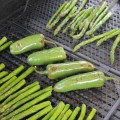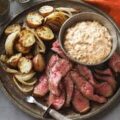Story by José C. Marmolejo
There’s got to be grilling in my genes. My attraction to fire goes back to my Boy Scout days and remains strong to this day. On weekends, when I spend a few hours outside playing with fire and food, my mind compares the experience to that of my dogs playing in the woods one afternoon.
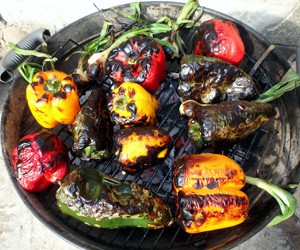
It is possible that cooking over an open fire started thousands of years ago with the al pastor technique: meat skewered on an inclined stick stuck in the ground. Sometime later, it was probably discovered that using a horizontally placed mesh—made out of green or wet sticks—was an easier and faster way to cook. Today, however, we’ll be dissecting grilling, the al pastor technique will have to wait.
We take the grill for granted. It makes so much sense and it’s so easy to use, that we don’t stop and think about the origin and evolution of the grill. What is the story behind that piece of cooking equipment we have outside that has evolved like a mouse trap to the sophistication we have today? No matter how simple or humble a version of a grill we may have, they all basically do the same: hold the burning wood or charcoal separate from the food but allow the heat to go through and up, improving the texture, flavor, and digestibility of our food. That simple steel mesh prevents our meat from touching the burning wood, coals, ashes or dirt. That little lever, adjusting vertically, gives us control over depth and speed of cooking by changing the distance between heat and food, it’s the source of much pleasure and satisfaction and happiness, but seldom gets any recognition. That’s my grill, a sublime invention…
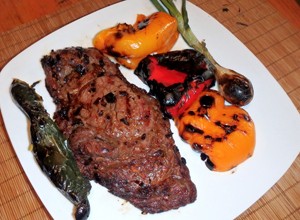
Ready for the knife and fork.
The Spaniards brought the cattle to what is now Mexico as well as their butchering method: cutting the meat lengthwise to the animal. The British, however, introduced their butchering method to the USA: cutting across the bones producing what we know as steaks. While the Spaniards grilled the long boneless pieces of meat over fire, the British decided that the steaks should be cooked on a cast iron skillet using butter, salt and pepper. Climate contributes to cooking techniques’ evolution and humans decide where cooking takes place.
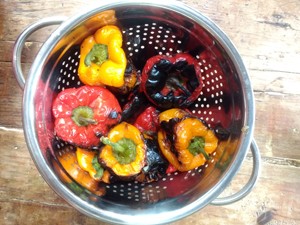
Roasted bell peppers
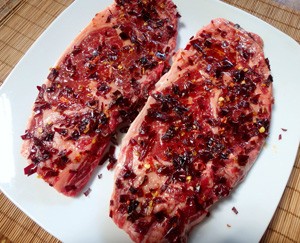
Beef with chiles and salt only, ready for grilling.
The journey starts with the search for the matches and wood or charcoal, only to realize there isn’t enough of either or both, but we get started with a drink anyway because what is a Mexican function without a good dose of cerveza, tequila, and improvisation? And since no one is on time, it doesn’t matter, etiquette only mandates that you call to advise that you are running late—any excuse will work—and you must ask if there’s something else needed from the store. And there’s always something needed from the store: matches, charcoal, ice, cigarettes, peanuts, more beer, among other things. Now, if you are going to be more than one hour late, you can easily be forgiven if you arrive with a special bottle of tequila or mezcal on hand that a friend or relative brought you from a distant place—the farther the better. An abundant amount of smiles will be your welcoming committee.
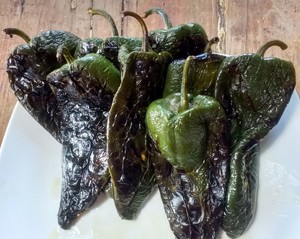
Roasted poblanos
Initial flames can be used to roast vegetables. Poblano chiles are my favorite grilling veggies, the smell is simply addictive; but any fresh chiles, bell peppers, onions, garlic, squash, and eggplant are also wonderful choices. I usually grill a week’s supply of vegetables. After the flames are gone, we’ll have red hot coals that are ideal to sear the meat—with salt and chile both sides—around a minute each side. My grilling meat is never more than one inch thick, thicker cuts go to the smoker, but that’s another story. Once searing is accomplished, I move the coals to one side of the grill and finish cooking the steak in the low heat area, a few minutes each side, medium rare is ready. Time to eat! Buen provecho! And remember: in Northern Mexico, grill time is not only for weekends anymore, grill time is all the time… Salud!
Good Grill recipes
Carne Asada Rub
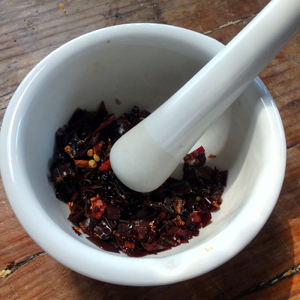
A simple but effective seasoning good for all meats going to the grill.
Ingredients
1 to 2 Tablespoons ground chile de árbol
1 to 2 Tablespoons crushed chile guajillo
1 Tablespoon sea salt
Cooking oil
Instructions
In a mortar, crush the salt with the chiles to a uniform mix. Rub the meat generously on both sides with the mix and let it rest for 12 hours refrigerated. A few minutes before cooking it, rub the meat gently with cooking oil in both sides. Meat is ready for the grill. If more pungency is desired increase the amount of chile de arbol powder.
Yield: 4 portions
Heat level: medium
Frijoles con Chicharrón
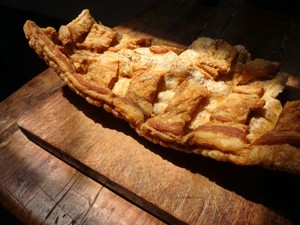
An easy way to flavor your beans to a real Mexican fiery flavor.
Ingredients
1 lb. Cooked beans
½ lb. Chicharrón con carne, fried pork skin with meat on it. Found on Mexican markets or restaurants that sell Carnitas de Puerco
¼ Onion chopped
1 Clove garlic minced
1 Habanero chile chopped
1 Serrano chile chopped
Cooking oil
Water
Instructions
Cut the chicharrón in small pieces (half of bite size) and lightly sautée it in oil it in low temperature to render the fat. Add the onion and cook until translucent. Add garlic and chiles and cook for no more than a minute. Add the beans and 1 cup of water. Bring to a boil and then simmer for 10 to 15 minutes. More water could be added as the chicharron will absorb it. Flavor will improve overnight. If less pungency is preferred, cut in half the amount of chiles.
Yield: 4 portions
Heat level: hot
Fresh Herbs and Chile Guajillo dressing
This salad dressing can also be used as a marinade for grilling meats. Changing the guajillo for the chile of your choice will make it your house dressing.
Note:I use a Tequila shot glass as a measuring unit.
Ingredients
2 to 3 shots of extra virgin olive oil. Using two shots of oil will yield a tart dressing. Using three shots of oil will yield an oily dressing that will also be suitable to marinate.
1 shot of white vinegar
2 Guajillo chiles stemmed and seeded, keep the veins.
Onion and garlic to taste (optional)
Salt to taste
Fresh herbs to taste. Choose one among cilantro, basilm and Arugula
Instructions
Mix all ingredients in a blender to desired texture.
Yield: 4 portions
Heat level: medium
Latest posts by José C. Marmolejo (see all)
- Unconventional Seafood Salsas - 04/25/2022
- Cocineras Tradicionales: The Traditional Cooks of Mexico - 04/01/2022
- Carnitas Calientes - 03/11/2022








